Marketing Analysis: Microsoft's Competitive Position and Strategy
VerifiedAdded on 2023/01/18
|15
|4215
|24
Report
AI Summary
This report provides a comprehensive marketing analysis of Microsoft, addressing key aspects such as its strengths and weaknesses, competitive position, and strategic approaches. The analysis begins with an overview of Microsoft's global operations, market valuation, and customer base, highlighting its strong brand awareness and widespread product adoption. It then delves into the company's weaknesses, including a lack of innovation in certain product lines and increasing vulnerability to cybercrime. The report examines Microsoft's marketing mix, evaluating its product offerings, global distribution, and pricing strategies. Furthermore, the report explores Microsoft's competitive position, employing Porter's Five Forces model to assess industry rivalry, supplier power, buyer power, the threat of new entrants, and the threat of substitutes. The report also analyzes market segmentation and positioning strategies, comparing Microsoft's approach to that of Apple, and detailing the application of the marketing mix to position products effectively. The report concludes with an examination of the three levels of product, with a focus on the core benefit, and the importance of product services in relation to the augmented product level.
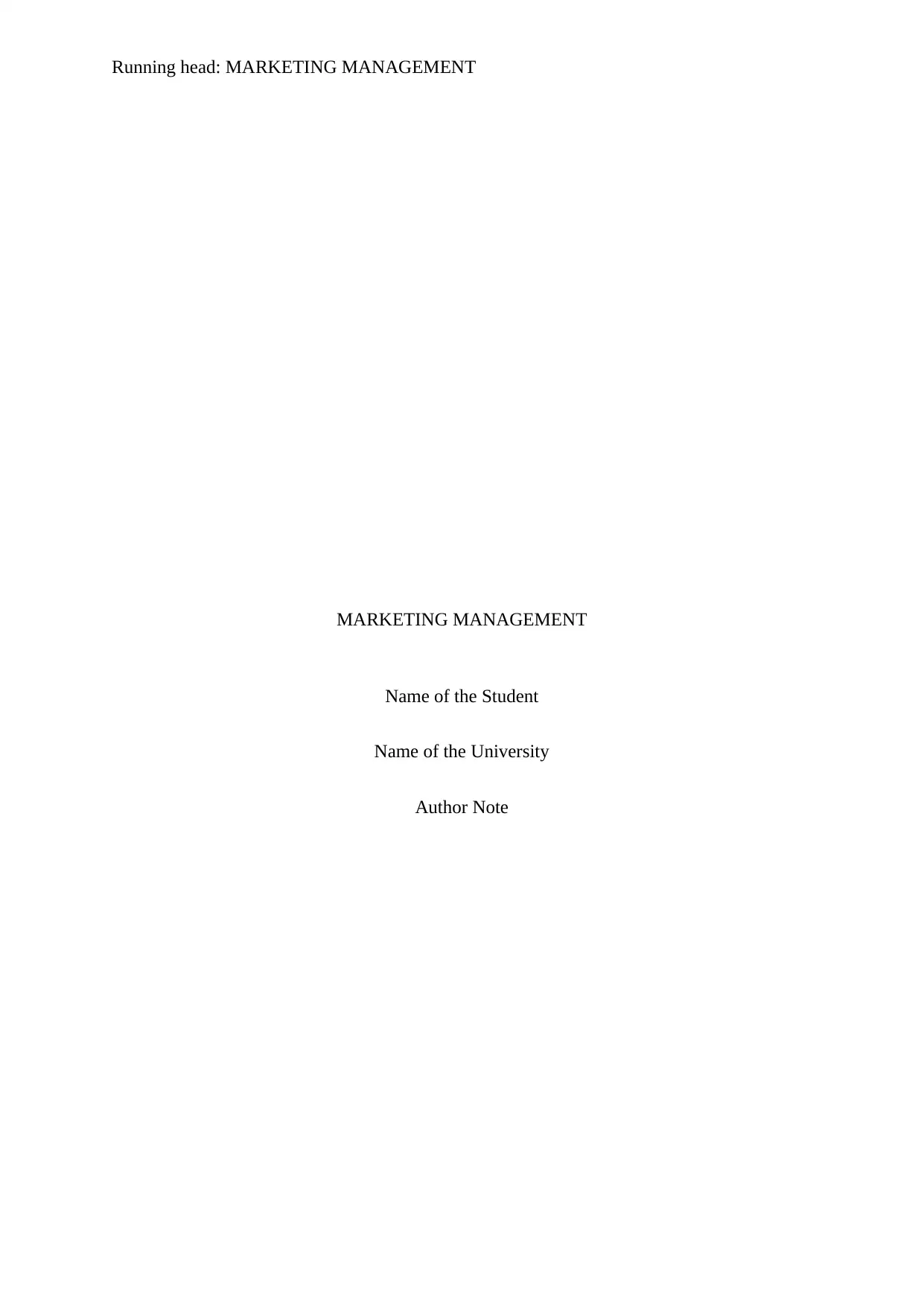
Running head: MARKETING MANAGEMENT
MARKETING MANAGEMENT
Name of the Student
Name of the University
Author Note
MARKETING MANAGEMENT
Name of the Student
Name of the University
Author Note
Paraphrase This Document
Need a fresh take? Get an instant paraphrase of this document with our AI Paraphraser
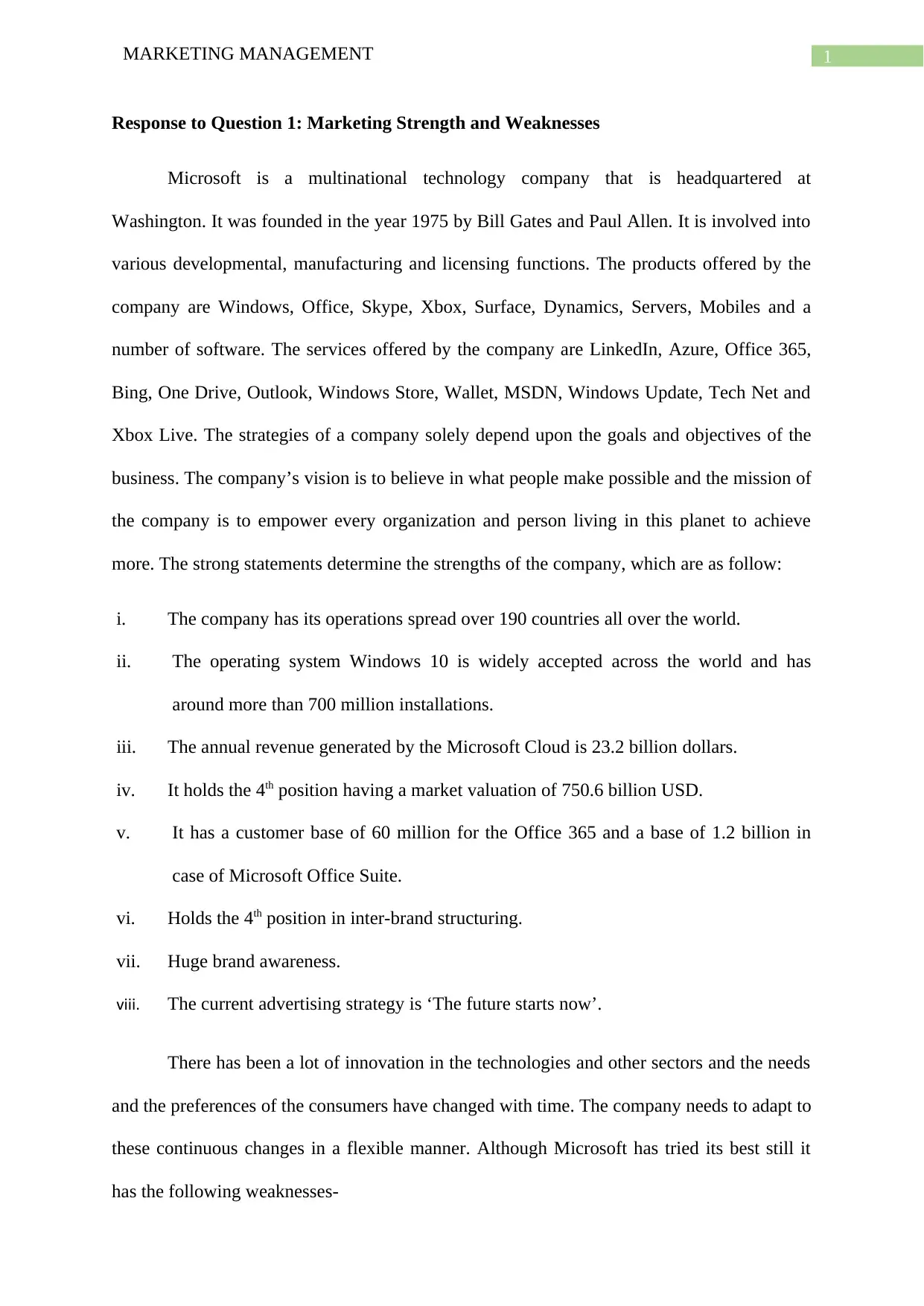
1MARKETING MANAGEMENT
Response to Question 1: Marketing Strength and Weaknesses
Microsoft is a multinational technology company that is headquartered at
Washington. It was founded in the year 1975 by Bill Gates and Paul Allen. It is involved into
various developmental, manufacturing and licensing functions. The products offered by the
company are Windows, Office, Skype, Xbox, Surface, Dynamics, Servers, Mobiles and a
number of software. The services offered by the company are LinkedIn, Azure, Office 365,
Bing, One Drive, Outlook, Windows Store, Wallet, MSDN, Windows Update, Tech Net and
Xbox Live. The strategies of a company solely depend upon the goals and objectives of the
business. The company’s vision is to believe in what people make possible and the mission of
the company is to empower every organization and person living in this planet to achieve
more. The strong statements determine the strengths of the company, which are as follow:
i. The company has its operations spread over 190 countries all over the world.
ii. The operating system Windows 10 is widely accepted across the world and has
around more than 700 million installations.
iii. The annual revenue generated by the Microsoft Cloud is 23.2 billion dollars.
iv. It holds the 4th position having a market valuation of 750.6 billion USD.
v. It has a customer base of 60 million for the Office 365 and a base of 1.2 billion in
case of Microsoft Office Suite.
vi. Holds the 4th position in inter-brand structuring.
vii. Huge brand awareness.
viii. The current advertising strategy is ‘The future starts now’.
There has been a lot of innovation in the technologies and other sectors and the needs
and the preferences of the consumers have changed with time. The company needs to adapt to
these continuous changes in a flexible manner. Although Microsoft has tried its best still it
has the following weaknesses-
Response to Question 1: Marketing Strength and Weaknesses
Microsoft is a multinational technology company that is headquartered at
Washington. It was founded in the year 1975 by Bill Gates and Paul Allen. It is involved into
various developmental, manufacturing and licensing functions. The products offered by the
company are Windows, Office, Skype, Xbox, Surface, Dynamics, Servers, Mobiles and a
number of software. The services offered by the company are LinkedIn, Azure, Office 365,
Bing, One Drive, Outlook, Windows Store, Wallet, MSDN, Windows Update, Tech Net and
Xbox Live. The strategies of a company solely depend upon the goals and objectives of the
business. The company’s vision is to believe in what people make possible and the mission of
the company is to empower every organization and person living in this planet to achieve
more. The strong statements determine the strengths of the company, which are as follow:
i. The company has its operations spread over 190 countries all over the world.
ii. The operating system Windows 10 is widely accepted across the world and has
around more than 700 million installations.
iii. The annual revenue generated by the Microsoft Cloud is 23.2 billion dollars.
iv. It holds the 4th position having a market valuation of 750.6 billion USD.
v. It has a customer base of 60 million for the Office 365 and a base of 1.2 billion in
case of Microsoft Office Suite.
vi. Holds the 4th position in inter-brand structuring.
vii. Huge brand awareness.
viii. The current advertising strategy is ‘The future starts now’.
There has been a lot of innovation in the technologies and other sectors and the needs
and the preferences of the consumers have changed with time. The company needs to adapt to
these continuous changes in a flexible manner. Although Microsoft has tried its best still it
has the following weaknesses-
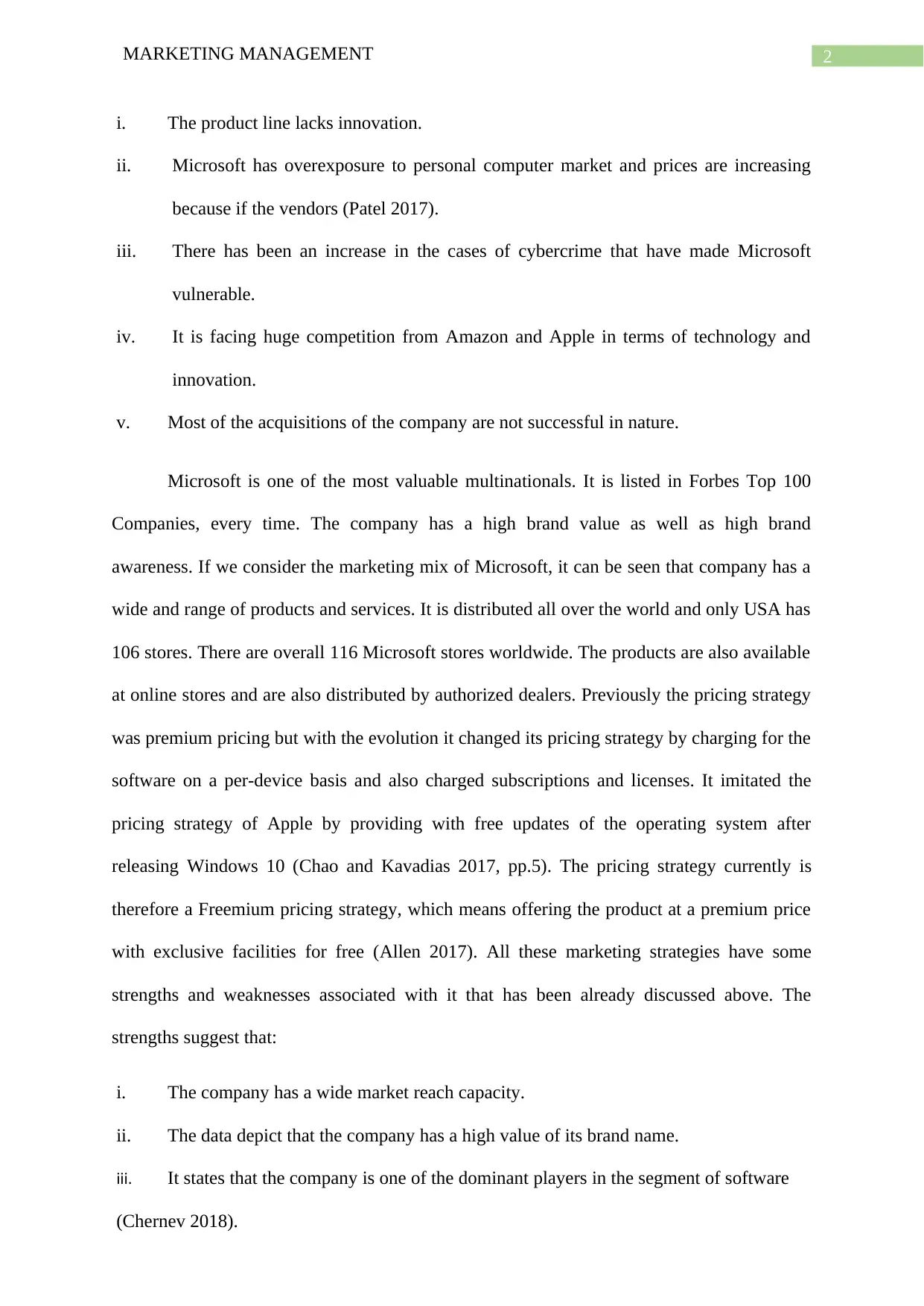
2MARKETING MANAGEMENT
i. The product line lacks innovation.
ii. Microsoft has overexposure to personal computer market and prices are increasing
because if the vendors (Patel 2017).
iii. There has been an increase in the cases of cybercrime that have made Microsoft
vulnerable.
iv. It is facing huge competition from Amazon and Apple in terms of technology and
innovation.
v. Most of the acquisitions of the company are not successful in nature.
Microsoft is one of the most valuable multinationals. It is listed in Forbes Top 100
Companies, every time. The company has a high brand value as well as high brand
awareness. If we consider the marketing mix of Microsoft, it can be seen that company has a
wide and range of products and services. It is distributed all over the world and only USA has
106 stores. There are overall 116 Microsoft stores worldwide. The products are also available
at online stores and are also distributed by authorized dealers. Previously the pricing strategy
was premium pricing but with the evolution it changed its pricing strategy by charging for the
software on a per-device basis and also charged subscriptions and licenses. It imitated the
pricing strategy of Apple by providing with free updates of the operating system after
releasing Windows 10 (Chao and Kavadias 2017, pp.5). The pricing strategy currently is
therefore a Freemium pricing strategy, which means offering the product at a premium price
with exclusive facilities for free (Allen 2017). All these marketing strategies have some
strengths and weaknesses associated with it that has been already discussed above. The
strengths suggest that:
i. The company has a wide market reach capacity.
ii. The data depict that the company has a high value of its brand name.
iii. It states that the company is one of the dominant players in the segment of software
(Chernev 2018).
i. The product line lacks innovation.
ii. Microsoft has overexposure to personal computer market and prices are increasing
because if the vendors (Patel 2017).
iii. There has been an increase in the cases of cybercrime that have made Microsoft
vulnerable.
iv. It is facing huge competition from Amazon and Apple in terms of technology and
innovation.
v. Most of the acquisitions of the company are not successful in nature.
Microsoft is one of the most valuable multinationals. It is listed in Forbes Top 100
Companies, every time. The company has a high brand value as well as high brand
awareness. If we consider the marketing mix of Microsoft, it can be seen that company has a
wide and range of products and services. It is distributed all over the world and only USA has
106 stores. There are overall 116 Microsoft stores worldwide. The products are also available
at online stores and are also distributed by authorized dealers. Previously the pricing strategy
was premium pricing but with the evolution it changed its pricing strategy by charging for the
software on a per-device basis and also charged subscriptions and licenses. It imitated the
pricing strategy of Apple by providing with free updates of the operating system after
releasing Windows 10 (Chao and Kavadias 2017, pp.5). The pricing strategy currently is
therefore a Freemium pricing strategy, which means offering the product at a premium price
with exclusive facilities for free (Allen 2017). All these marketing strategies have some
strengths and weaknesses associated with it that has been already discussed above. The
strengths suggest that:
i. The company has a wide market reach capacity.
ii. The data depict that the company has a high value of its brand name.
iii. It states that the company is one of the dominant players in the segment of software
(Chernev 2018).
⊘ This is a preview!⊘
Do you want full access?
Subscribe today to unlock all pages.

Trusted by 1+ million students worldwide
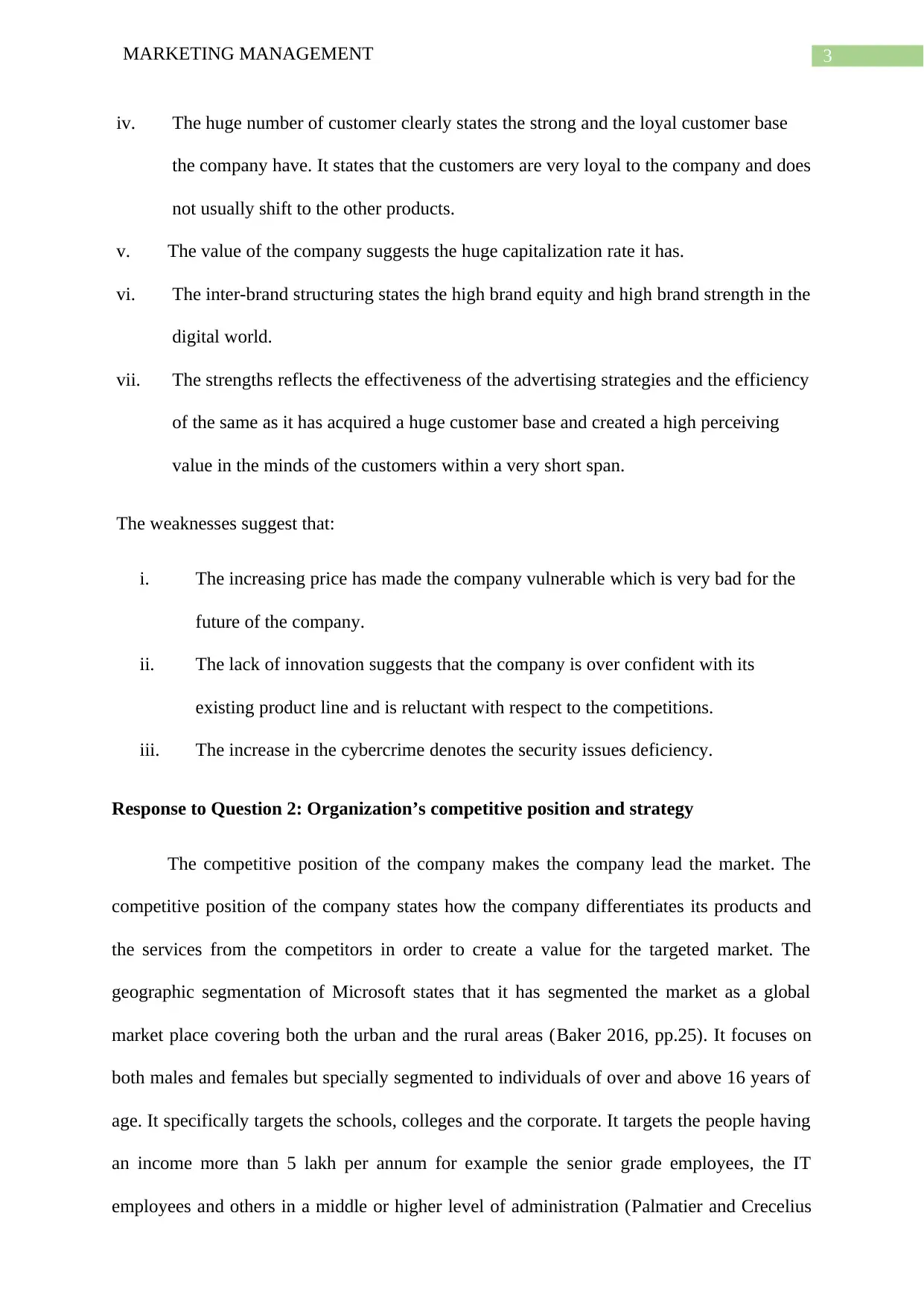
3MARKETING MANAGEMENT
iv. The huge number of customer clearly states the strong and the loyal customer base
the company have. It states that the customers are very loyal to the company and does
not usually shift to the other products.
v. The value of the company suggests the huge capitalization rate it has.
vi. The inter-brand structuring states the high brand equity and high brand strength in the
digital world.
vii. The strengths reflects the effectiveness of the advertising strategies and the efficiency
of the same as it has acquired a huge customer base and created a high perceiving
value in the minds of the customers within a very short span.
The weaknesses suggest that:
i. The increasing price has made the company vulnerable which is very bad for the
future of the company.
ii. The lack of innovation suggests that the company is over confident with its
existing product line and is reluctant with respect to the competitions.
iii. The increase in the cybercrime denotes the security issues deficiency.
Response to Question 2: Organization’s competitive position and strategy
The competitive position of the company makes the company lead the market. The
competitive position of the company states how the company differentiates its products and
the services from the competitors in order to create a value for the targeted market. The
geographic segmentation of Microsoft states that it has segmented the market as a global
market place covering both the urban and the rural areas (Baker 2016, pp.25). It focuses on
both males and females but specially segmented to individuals of over and above 16 years of
age. It specifically targets the schools, colleges and the corporate. It targets the people having
an income more than 5 lakh per annum for example the senior grade employees, the IT
employees and others in a middle or higher level of administration (Palmatier and Crecelius
iv. The huge number of customer clearly states the strong and the loyal customer base
the company have. It states that the customers are very loyal to the company and does
not usually shift to the other products.
v. The value of the company suggests the huge capitalization rate it has.
vi. The inter-brand structuring states the high brand equity and high brand strength in the
digital world.
vii. The strengths reflects the effectiveness of the advertising strategies and the efficiency
of the same as it has acquired a huge customer base and created a high perceiving
value in the minds of the customers within a very short span.
The weaknesses suggest that:
i. The increasing price has made the company vulnerable which is very bad for the
future of the company.
ii. The lack of innovation suggests that the company is over confident with its
existing product line and is reluctant with respect to the competitions.
iii. The increase in the cybercrime denotes the security issues deficiency.
Response to Question 2: Organization’s competitive position and strategy
The competitive position of the company makes the company lead the market. The
competitive position of the company states how the company differentiates its products and
the services from the competitors in order to create a value for the targeted market. The
geographic segmentation of Microsoft states that it has segmented the market as a global
market place covering both the urban and the rural areas (Baker 2016, pp.25). It focuses on
both males and females but specially segmented to individuals of over and above 16 years of
age. It specifically targets the schools, colleges and the corporate. It targets the people having
an income more than 5 lakh per annum for example the senior grade employees, the IT
employees and others in a middle or higher level of administration (Palmatier and Crecelius
Paraphrase This Document
Need a fresh take? Get an instant paraphrase of this document with our AI Paraphraser
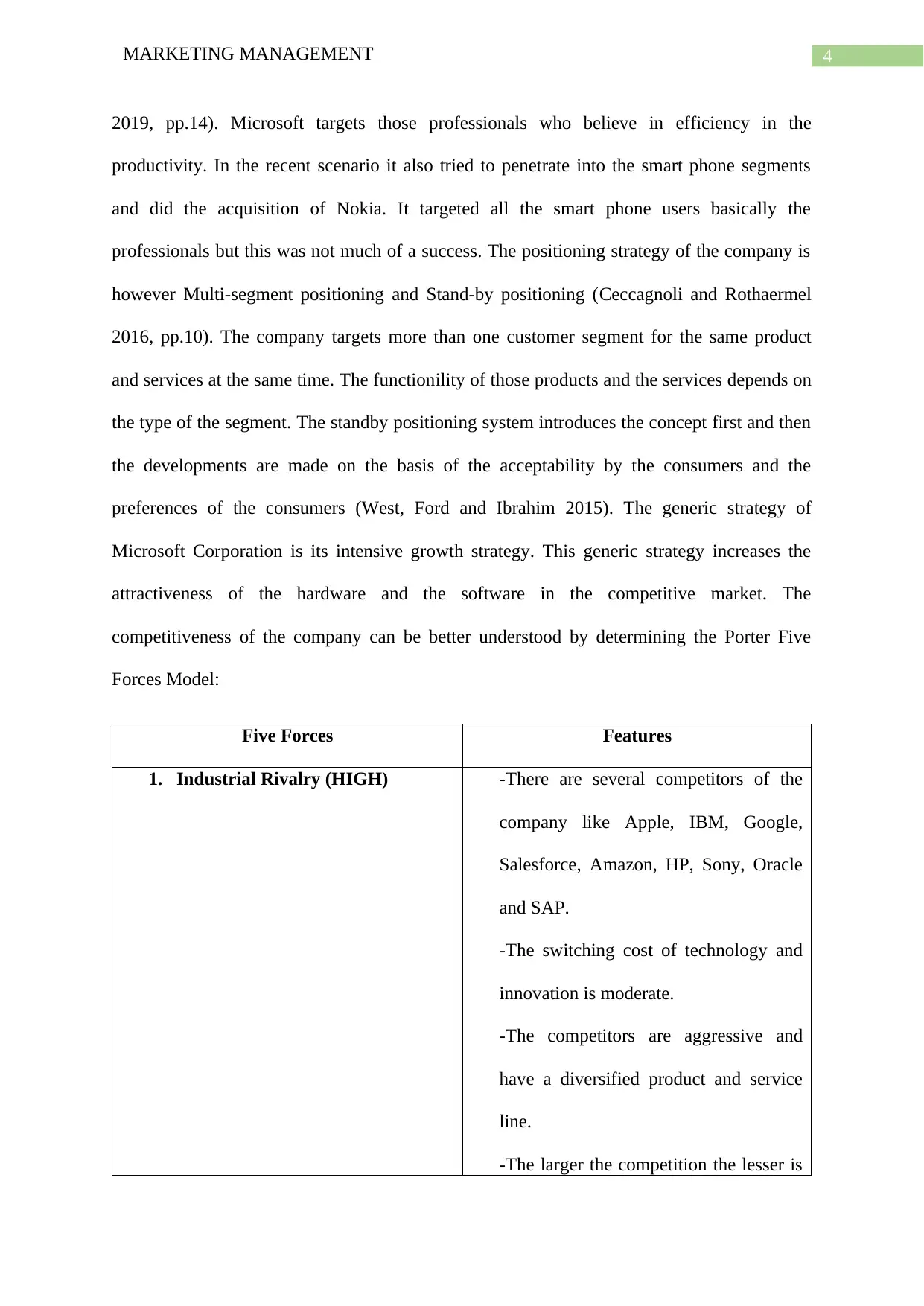
4MARKETING MANAGEMENT
2019, pp.14). Microsoft targets those professionals who believe in efficiency in the
productivity. In the recent scenario it also tried to penetrate into the smart phone segments
and did the acquisition of Nokia. It targeted all the smart phone users basically the
professionals but this was not much of a success. The positioning strategy of the company is
however Multi-segment positioning and Stand-by positioning (Ceccagnoli and Rothaermel
2016, pp.10). The company targets more than one customer segment for the same product
and services at the same time. The functionility of those products and the services depends on
the type of the segment. The standby positioning system introduces the concept first and then
the developments are made on the basis of the acceptability by the consumers and the
preferences of the consumers (West, Ford and Ibrahim 2015). The generic strategy of
Microsoft Corporation is its intensive growth strategy. This generic strategy increases the
attractiveness of the hardware and the software in the competitive market. The
competitiveness of the company can be better understood by determining the Porter Five
Forces Model:
Five Forces Features
1. Industrial Rivalry (HIGH) -There are several competitors of the
company like Apple, IBM, Google,
Salesforce, Amazon, HP, Sony, Oracle
and SAP.
-The switching cost of technology and
innovation is moderate.
-The competitors are aggressive and
have a diversified product and service
line.
-The larger the competition the lesser is
2019, pp.14). Microsoft targets those professionals who believe in efficiency in the
productivity. In the recent scenario it also tried to penetrate into the smart phone segments
and did the acquisition of Nokia. It targeted all the smart phone users basically the
professionals but this was not much of a success. The positioning strategy of the company is
however Multi-segment positioning and Stand-by positioning (Ceccagnoli and Rothaermel
2016, pp.10). The company targets more than one customer segment for the same product
and services at the same time. The functionility of those products and the services depends on
the type of the segment. The standby positioning system introduces the concept first and then
the developments are made on the basis of the acceptability by the consumers and the
preferences of the consumers (West, Ford and Ibrahim 2015). The generic strategy of
Microsoft Corporation is its intensive growth strategy. This generic strategy increases the
attractiveness of the hardware and the software in the competitive market. The
competitiveness of the company can be better understood by determining the Porter Five
Forces Model:
Five Forces Features
1. Industrial Rivalry (HIGH) -There are several competitors of the
company like Apple, IBM, Google,
Salesforce, Amazon, HP, Sony, Oracle
and SAP.
-The switching cost of technology and
innovation is moderate.
-The competitors are aggressive and
have a diversified product and service
line.
-The larger the competition the lesser is
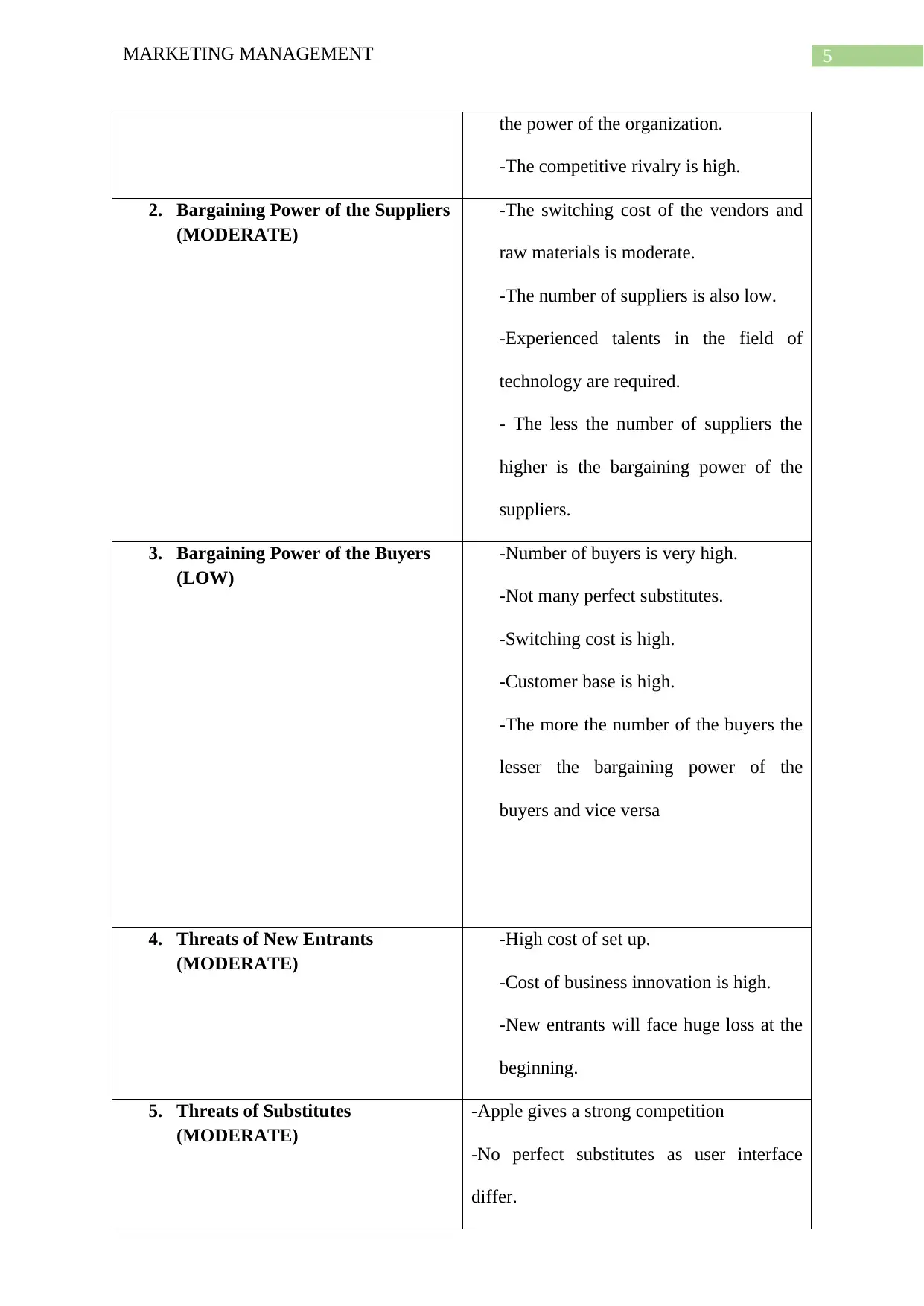
5MARKETING MANAGEMENT
the power of the organization.
-The competitive rivalry is high.
2. Bargaining Power of the Suppliers
(MODERATE)
-The switching cost of the vendors and
raw materials is moderate.
-The number of suppliers is also low.
-Experienced talents in the field of
technology are required.
- The less the number of suppliers the
higher is the bargaining power of the
suppliers.
3. Bargaining Power of the Buyers
(LOW)
-Number of buyers is very high.
-Not many perfect substitutes.
-Switching cost is high.
-Customer base is high.
-The more the number of the buyers the
lesser the bargaining power of the
buyers and vice versa
4. Threats of New Entrants
(MODERATE)
-High cost of set up.
-Cost of business innovation is high.
-New entrants will face huge loss at the
beginning.
5. Threats of Substitutes
(MODERATE)
-Apple gives a strong competition
-No perfect substitutes as user interface
differ.
the power of the organization.
-The competitive rivalry is high.
2. Bargaining Power of the Suppliers
(MODERATE)
-The switching cost of the vendors and
raw materials is moderate.
-The number of suppliers is also low.
-Experienced talents in the field of
technology are required.
- The less the number of suppliers the
higher is the bargaining power of the
suppliers.
3. Bargaining Power of the Buyers
(LOW)
-Number of buyers is very high.
-Not many perfect substitutes.
-Switching cost is high.
-Customer base is high.
-The more the number of the buyers the
lesser the bargaining power of the
buyers and vice versa
4. Threats of New Entrants
(MODERATE)
-High cost of set up.
-Cost of business innovation is high.
-New entrants will face huge loss at the
beginning.
5. Threats of Substitutes
(MODERATE)
-Apple gives a strong competition
-No perfect substitutes as user interface
differ.
⊘ This is a preview!⊘
Do you want full access?
Subscribe today to unlock all pages.

Trusted by 1+ million students worldwide
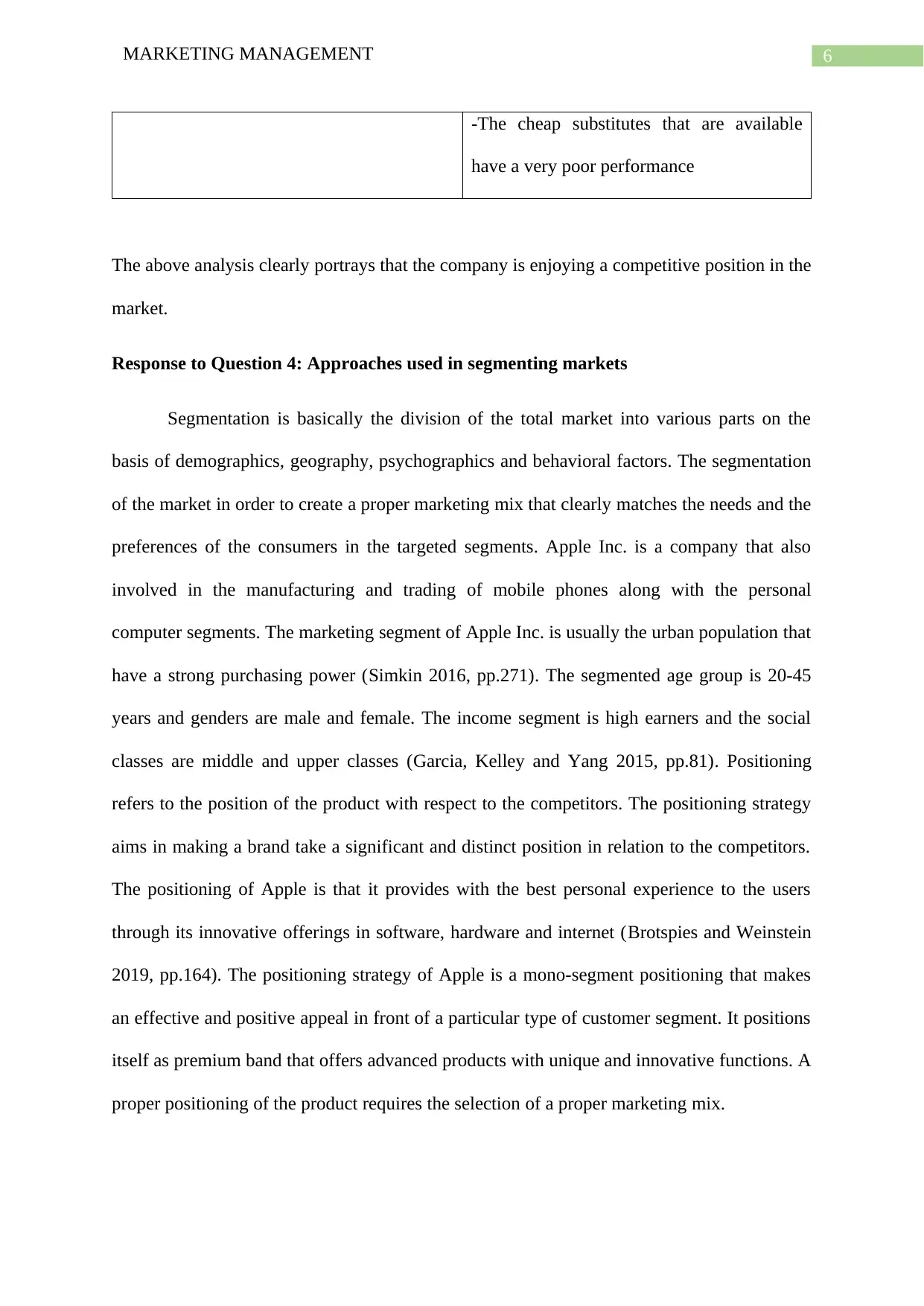
6MARKETING MANAGEMENT
-The cheap substitutes that are available
have a very poor performance
The above analysis clearly portrays that the company is enjoying a competitive position in the
market.
Response to Question 4: Approaches used in segmenting markets
Segmentation is basically the division of the total market into various parts on the
basis of demographics, geography, psychographics and behavioral factors. The segmentation
of the market in order to create a proper marketing mix that clearly matches the needs and the
preferences of the consumers in the targeted segments. Apple Inc. is a company that also
involved in the manufacturing and trading of mobile phones along with the personal
computer segments. The marketing segment of Apple Inc. is usually the urban population that
have a strong purchasing power (Simkin 2016, pp.271). The segmented age group is 20-45
years and genders are male and female. The income segment is high earners and the social
classes are middle and upper classes (Garcia, Kelley and Yang 2015, pp.81). Positioning
refers to the position of the product with respect to the competitors. The positioning strategy
aims in making a brand take a significant and distinct position in relation to the competitors.
The positioning of Apple is that it provides with the best personal experience to the users
through its innovative offerings in software, hardware and internet (Brotspies and Weinstein
2019, pp.164). The positioning strategy of Apple is a mono-segment positioning that makes
an effective and positive appeal in front of a particular type of customer segment. It positions
itself as premium band that offers advanced products with unique and innovative functions. A
proper positioning of the product requires the selection of a proper marketing mix.
-The cheap substitutes that are available
have a very poor performance
The above analysis clearly portrays that the company is enjoying a competitive position in the
market.
Response to Question 4: Approaches used in segmenting markets
Segmentation is basically the division of the total market into various parts on the
basis of demographics, geography, psychographics and behavioral factors. The segmentation
of the market in order to create a proper marketing mix that clearly matches the needs and the
preferences of the consumers in the targeted segments. Apple Inc. is a company that also
involved in the manufacturing and trading of mobile phones along with the personal
computer segments. The marketing segment of Apple Inc. is usually the urban population that
have a strong purchasing power (Simkin 2016, pp.271). The segmented age group is 20-45
years and genders are male and female. The income segment is high earners and the social
classes are middle and upper classes (Garcia, Kelley and Yang 2015, pp.81). Positioning
refers to the position of the product with respect to the competitors. The positioning strategy
aims in making a brand take a significant and distinct position in relation to the competitors.
The positioning of Apple is that it provides with the best personal experience to the users
through its innovative offerings in software, hardware and internet (Brotspies and Weinstein
2019, pp.164). The positioning strategy of Apple is a mono-segment positioning that makes
an effective and positive appeal in front of a particular type of customer segment. It positions
itself as premium band that offers advanced products with unique and innovative functions. A
proper positioning of the product requires the selection of a proper marketing mix.
Paraphrase This Document
Need a fresh take? Get an instant paraphrase of this document with our AI Paraphraser
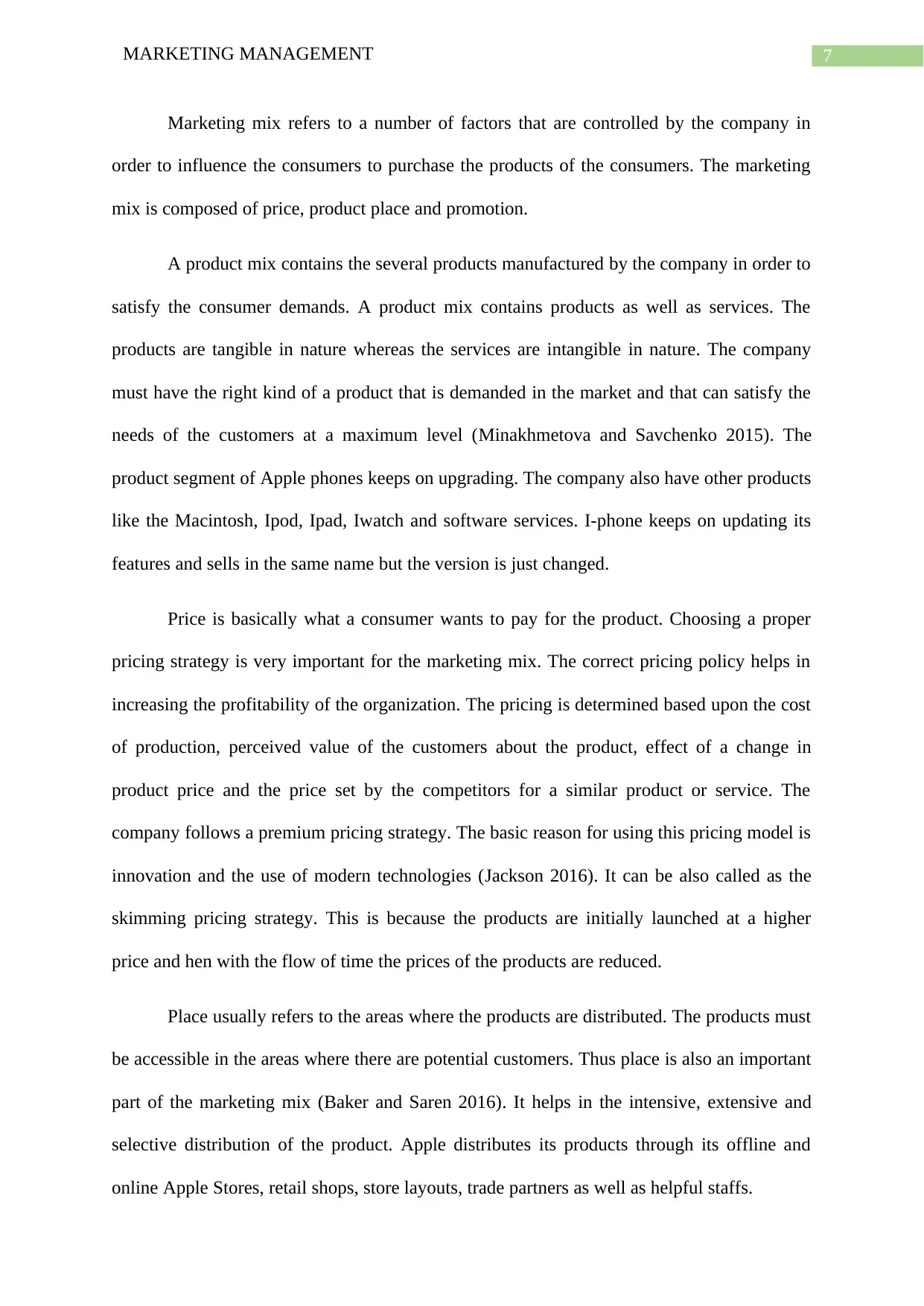
7MARKETING MANAGEMENT
Marketing mix refers to a number of factors that are controlled by the company in
order to influence the consumers to purchase the products of the consumers. The marketing
mix is composed of price, product place and promotion.
A product mix contains the several products manufactured by the company in order to
satisfy the consumer demands. A product mix contains products as well as services. The
products are tangible in nature whereas the services are intangible in nature. The company
must have the right kind of a product that is demanded in the market and that can satisfy the
needs of the customers at a maximum level (Minakhmetova and Savchenko 2015). The
product segment of Apple phones keeps on upgrading. The company also have other products
like the Macintosh, Ipod, Ipad, Iwatch and software services. I-phone keeps on updating its
features and sells in the same name but the version is just changed.
Price is basically what a consumer wants to pay for the product. Choosing a proper
pricing strategy is very important for the marketing mix. The correct pricing policy helps in
increasing the profitability of the organization. The pricing is determined based upon the cost
of production, perceived value of the customers about the product, effect of a change in
product price and the price set by the competitors for a similar product or service. The
company follows a premium pricing strategy. The basic reason for using this pricing model is
innovation and the use of modern technologies (Jackson 2016). It can be also called as the
skimming pricing strategy. This is because the products are initially launched at a higher
price and hen with the flow of time the prices of the products are reduced.
Place usually refers to the areas where the products are distributed. The products must
be accessible in the areas where there are potential customers. Thus place is also an important
part of the marketing mix (Baker and Saren 2016). It helps in the intensive, extensive and
selective distribution of the product. Apple distributes its products through its offline and
online Apple Stores, retail shops, store layouts, trade partners as well as helpful staffs.
Marketing mix refers to a number of factors that are controlled by the company in
order to influence the consumers to purchase the products of the consumers. The marketing
mix is composed of price, product place and promotion.
A product mix contains the several products manufactured by the company in order to
satisfy the consumer demands. A product mix contains products as well as services. The
products are tangible in nature whereas the services are intangible in nature. The company
must have the right kind of a product that is demanded in the market and that can satisfy the
needs of the customers at a maximum level (Minakhmetova and Savchenko 2015). The
product segment of Apple phones keeps on upgrading. The company also have other products
like the Macintosh, Ipod, Ipad, Iwatch and software services. I-phone keeps on updating its
features and sells in the same name but the version is just changed.
Price is basically what a consumer wants to pay for the product. Choosing a proper
pricing strategy is very important for the marketing mix. The correct pricing policy helps in
increasing the profitability of the organization. The pricing is determined based upon the cost
of production, perceived value of the customers about the product, effect of a change in
product price and the price set by the competitors for a similar product or service. The
company follows a premium pricing strategy. The basic reason for using this pricing model is
innovation and the use of modern technologies (Jackson 2016). It can be also called as the
skimming pricing strategy. This is because the products are initially launched at a higher
price and hen with the flow of time the prices of the products are reduced.
Place usually refers to the areas where the products are distributed. The products must
be accessible in the areas where there are potential customers. Thus place is also an important
part of the marketing mix (Baker and Saren 2016). It helps in the intensive, extensive and
selective distribution of the product. Apple distributes its products through its offline and
online Apple Stores, retail shops, store layouts, trade partners as well as helpful staffs.
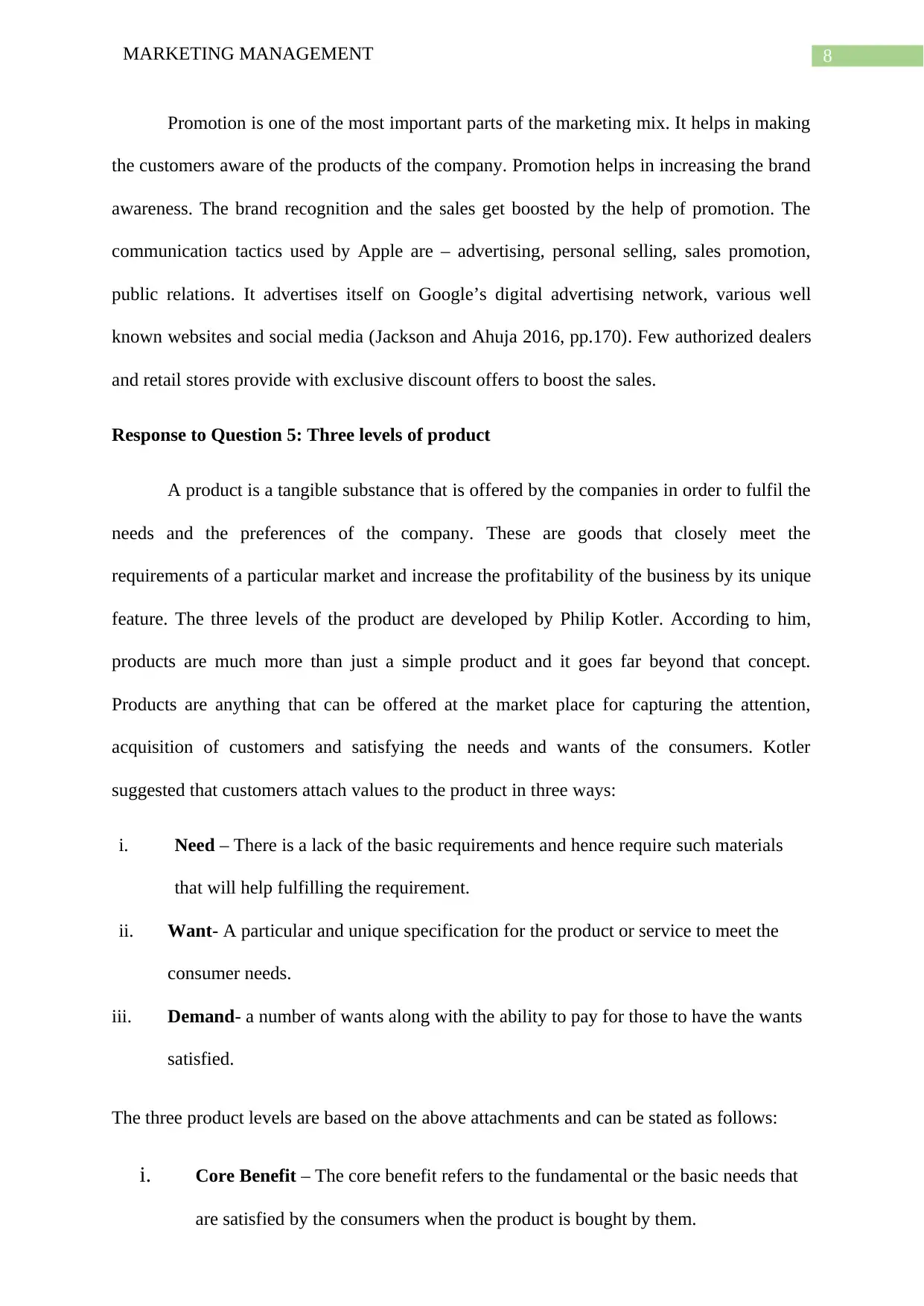
8MARKETING MANAGEMENT
Promotion is one of the most important parts of the marketing mix. It helps in making
the customers aware of the products of the company. Promotion helps in increasing the brand
awareness. The brand recognition and the sales get boosted by the help of promotion. The
communication tactics used by Apple are – advertising, personal selling, sales promotion,
public relations. It advertises itself on Google’s digital advertising network, various well
known websites and social media (Jackson and Ahuja 2016, pp.170). Few authorized dealers
and retail stores provide with exclusive discount offers to boost the sales.
Response to Question 5: Three levels of product
A product is a tangible substance that is offered by the companies in order to fulfil the
needs and the preferences of the company. These are goods that closely meet the
requirements of a particular market and increase the profitability of the business by its unique
feature. The three levels of the product are developed by Philip Kotler. According to him,
products are much more than just a simple product and it goes far beyond that concept.
Products are anything that can be offered at the market place for capturing the attention,
acquisition of customers and satisfying the needs and wants of the consumers. Kotler
suggested that customers attach values to the product in three ways:
i. Need – There is a lack of the basic requirements and hence require such materials
that will help fulfilling the requirement.
ii. Want- A particular and unique specification for the product or service to meet the
consumer needs.
iii. Demand- a number of wants along with the ability to pay for those to have the wants
satisfied.
The three product levels are based on the above attachments and can be stated as follows:
i. Core Benefit – The core benefit refers to the fundamental or the basic needs that
are satisfied by the consumers when the product is bought by them.
Promotion is one of the most important parts of the marketing mix. It helps in making
the customers aware of the products of the company. Promotion helps in increasing the brand
awareness. The brand recognition and the sales get boosted by the help of promotion. The
communication tactics used by Apple are – advertising, personal selling, sales promotion,
public relations. It advertises itself on Google’s digital advertising network, various well
known websites and social media (Jackson and Ahuja 2016, pp.170). Few authorized dealers
and retail stores provide with exclusive discount offers to boost the sales.
Response to Question 5: Three levels of product
A product is a tangible substance that is offered by the companies in order to fulfil the
needs and the preferences of the company. These are goods that closely meet the
requirements of a particular market and increase the profitability of the business by its unique
feature. The three levels of the product are developed by Philip Kotler. According to him,
products are much more than just a simple product and it goes far beyond that concept.
Products are anything that can be offered at the market place for capturing the attention,
acquisition of customers and satisfying the needs and wants of the consumers. Kotler
suggested that customers attach values to the product in three ways:
i. Need – There is a lack of the basic requirements and hence require such materials
that will help fulfilling the requirement.
ii. Want- A particular and unique specification for the product or service to meet the
consumer needs.
iii. Demand- a number of wants along with the ability to pay for those to have the wants
satisfied.
The three product levels are based on the above attachments and can be stated as follows:
i. Core Benefit – The core benefit refers to the fundamental or the basic needs that
are satisfied by the consumers when the product is bought by them.
⊘ This is a preview!⊘
Do you want full access?
Subscribe today to unlock all pages.

Trusted by 1+ million students worldwide
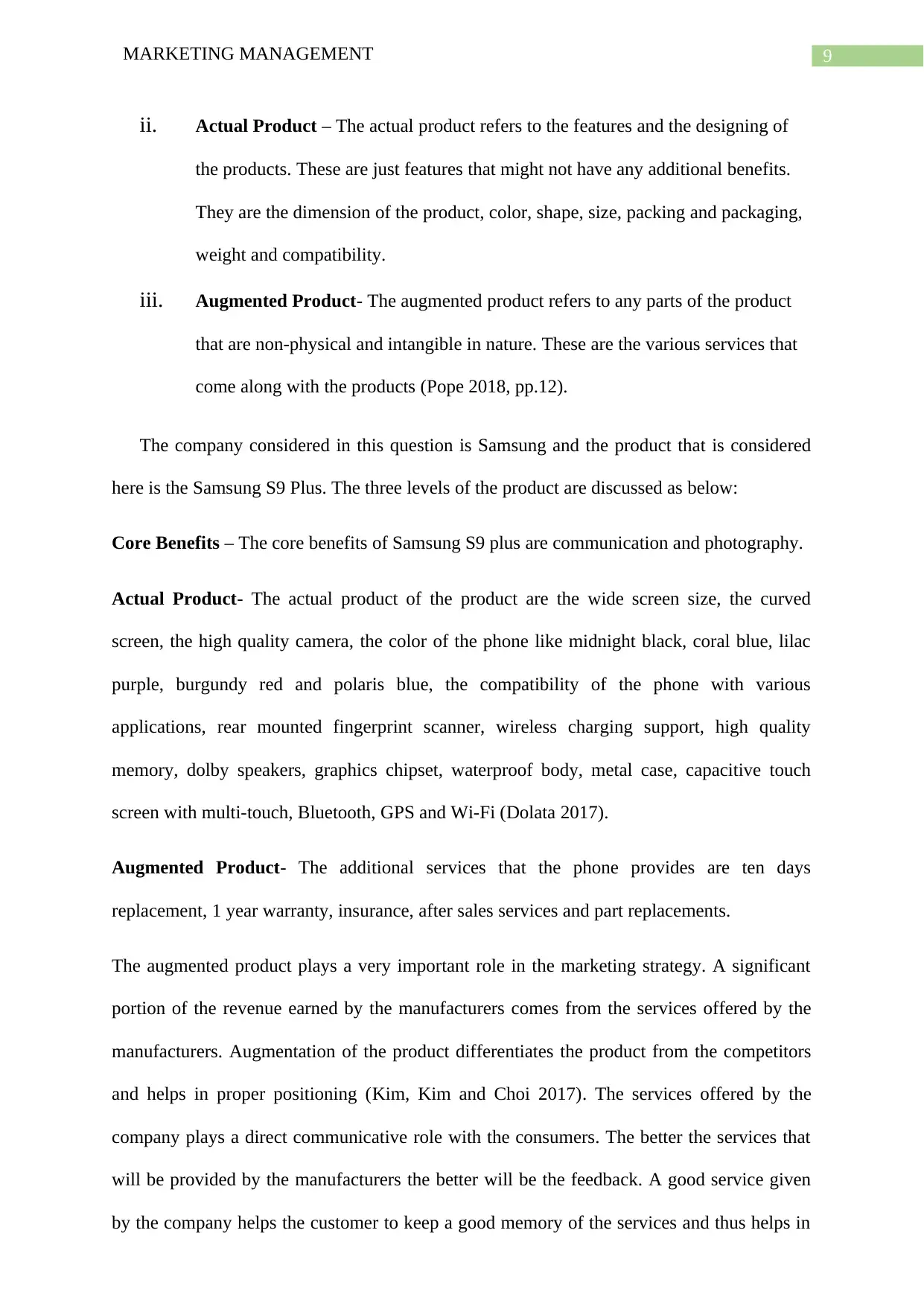
9MARKETING MANAGEMENT
ii. Actual Product – The actual product refers to the features and the designing of
the products. These are just features that might not have any additional benefits.
They are the dimension of the product, color, shape, size, packing and packaging,
weight and compatibility.
iii. Augmented Product- The augmented product refers to any parts of the product
that are non-physical and intangible in nature. These are the various services that
come along with the products (Pope 2018, pp.12).
The company considered in this question is Samsung and the product that is considered
here is the Samsung S9 Plus. The three levels of the product are discussed as below:
Core Benefits – The core benefits of Samsung S9 plus are communication and photography.
Actual Product- The actual product of the product are the wide screen size, the curved
screen, the high quality camera, the color of the phone like midnight black, coral blue, lilac
purple, burgundy red and polaris blue, the compatibility of the phone with various
applications, rear mounted fingerprint scanner, wireless charging support, high quality
memory, dolby speakers, graphics chipset, waterproof body, metal case, capacitive touch
screen with multi-touch, Bluetooth, GPS and Wi-Fi (Dolata 2017).
Augmented Product- The additional services that the phone provides are ten days
replacement, 1 year warranty, insurance, after sales services and part replacements.
The augmented product plays a very important role in the marketing strategy. A significant
portion of the revenue earned by the manufacturers comes from the services offered by the
manufacturers. Augmentation of the product differentiates the product from the competitors
and helps in proper positioning (Kim, Kim and Choi 2017). The services offered by the
company plays a direct communicative role with the consumers. The better the services that
will be provided by the manufacturers the better will be the feedback. A good service given
by the company helps the customer to keep a good memory of the services and thus helps in
ii. Actual Product – The actual product refers to the features and the designing of
the products. These are just features that might not have any additional benefits.
They are the dimension of the product, color, shape, size, packing and packaging,
weight and compatibility.
iii. Augmented Product- The augmented product refers to any parts of the product
that are non-physical and intangible in nature. These are the various services that
come along with the products (Pope 2018, pp.12).
The company considered in this question is Samsung and the product that is considered
here is the Samsung S9 Plus. The three levels of the product are discussed as below:
Core Benefits – The core benefits of Samsung S9 plus are communication and photography.
Actual Product- The actual product of the product are the wide screen size, the curved
screen, the high quality camera, the color of the phone like midnight black, coral blue, lilac
purple, burgundy red and polaris blue, the compatibility of the phone with various
applications, rear mounted fingerprint scanner, wireless charging support, high quality
memory, dolby speakers, graphics chipset, waterproof body, metal case, capacitive touch
screen with multi-touch, Bluetooth, GPS and Wi-Fi (Dolata 2017).
Augmented Product- The additional services that the phone provides are ten days
replacement, 1 year warranty, insurance, after sales services and part replacements.
The augmented product plays a very important role in the marketing strategy. A significant
portion of the revenue earned by the manufacturers comes from the services offered by the
manufacturers. Augmentation of the product differentiates the product from the competitors
and helps in proper positioning (Kim, Kim and Choi 2017). The services offered by the
company plays a direct communicative role with the consumers. The better the services that
will be provided by the manufacturers the better will be the feedback. A good service given
by the company helps the customer to keep a good memory of the services and thus helps in
Paraphrase This Document
Need a fresh take? Get an instant paraphrase of this document with our AI Paraphraser
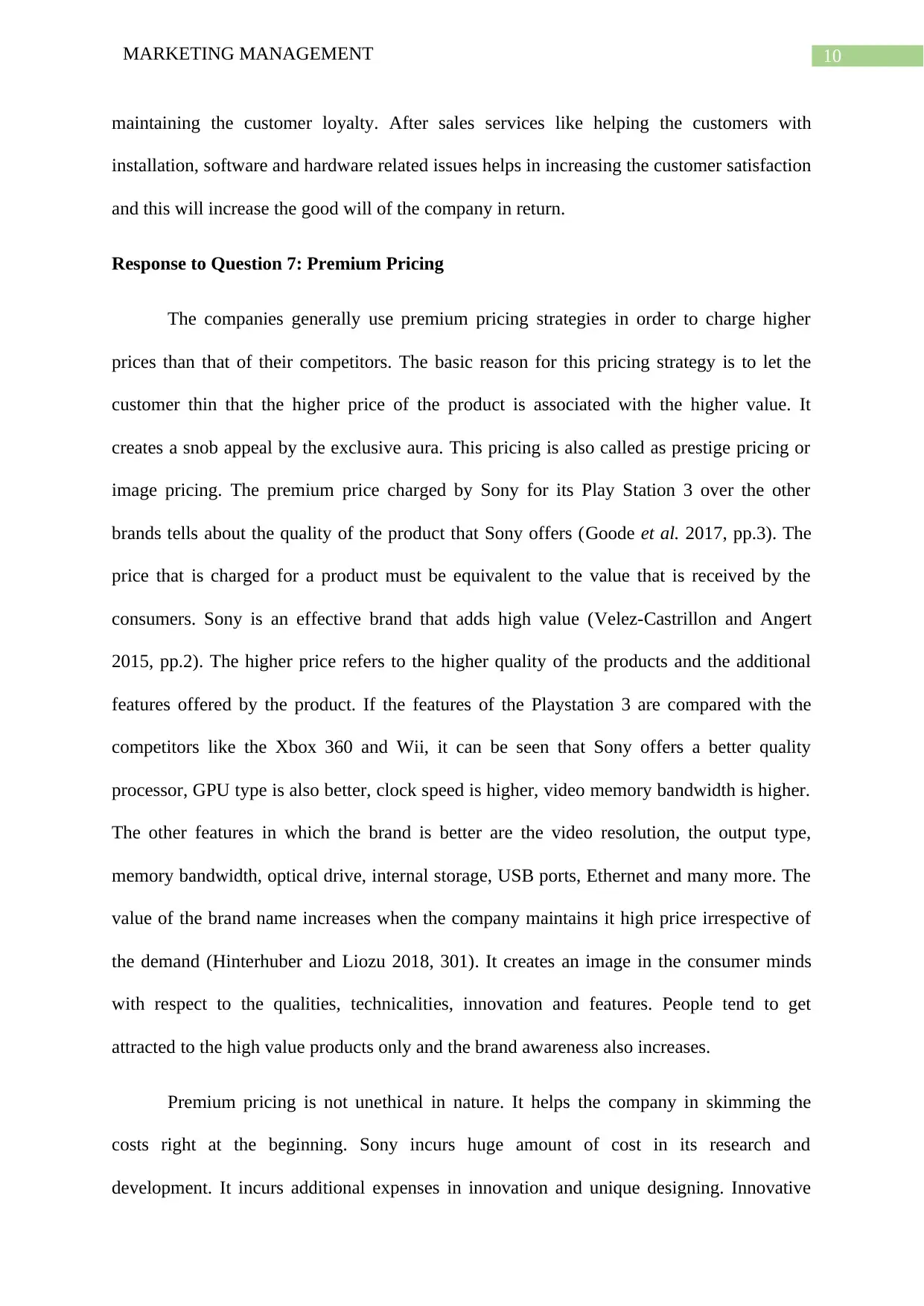
10MARKETING MANAGEMENT
maintaining the customer loyalty. After sales services like helping the customers with
installation, software and hardware related issues helps in increasing the customer satisfaction
and this will increase the good will of the company in return.
Response to Question 7: Premium Pricing
The companies generally use premium pricing strategies in order to charge higher
prices than that of their competitors. The basic reason for this pricing strategy is to let the
customer thin that the higher price of the product is associated with the higher value. It
creates a snob appeal by the exclusive aura. This pricing is also called as prestige pricing or
image pricing. The premium price charged by Sony for its Play Station 3 over the other
brands tells about the quality of the product that Sony offers (Goode et al. 2017, pp.3). The
price that is charged for a product must be equivalent to the value that is received by the
consumers. Sony is an effective brand that adds high value (Velez-Castrillon and Angert
2015, pp.2). The higher price refers to the higher quality of the products and the additional
features offered by the product. If the features of the Playstation 3 are compared with the
competitors like the Xbox 360 and Wii, it can be seen that Sony offers a better quality
processor, GPU type is also better, clock speed is higher, video memory bandwidth is higher.
The other features in which the brand is better are the video resolution, the output type,
memory bandwidth, optical drive, internal storage, USB ports, Ethernet and many more. The
value of the brand name increases when the company maintains it high price irrespective of
the demand (Hinterhuber and Liozu 2018, 301). It creates an image in the consumer minds
with respect to the qualities, technicalities, innovation and features. People tend to get
attracted to the high value products only and the brand awareness also increases.
Premium pricing is not unethical in nature. It helps the company in skimming the
costs right at the beginning. Sony incurs huge amount of cost in its research and
development. It incurs additional expenses in innovation and unique designing. Innovative
maintaining the customer loyalty. After sales services like helping the customers with
installation, software and hardware related issues helps in increasing the customer satisfaction
and this will increase the good will of the company in return.
Response to Question 7: Premium Pricing
The companies generally use premium pricing strategies in order to charge higher
prices than that of their competitors. The basic reason for this pricing strategy is to let the
customer thin that the higher price of the product is associated with the higher value. It
creates a snob appeal by the exclusive aura. This pricing is also called as prestige pricing or
image pricing. The premium price charged by Sony for its Play Station 3 over the other
brands tells about the quality of the product that Sony offers (Goode et al. 2017, pp.3). The
price that is charged for a product must be equivalent to the value that is received by the
consumers. Sony is an effective brand that adds high value (Velez-Castrillon and Angert
2015, pp.2). The higher price refers to the higher quality of the products and the additional
features offered by the product. If the features of the Playstation 3 are compared with the
competitors like the Xbox 360 and Wii, it can be seen that Sony offers a better quality
processor, GPU type is also better, clock speed is higher, video memory bandwidth is higher.
The other features in which the brand is better are the video resolution, the output type,
memory bandwidth, optical drive, internal storage, USB ports, Ethernet and many more. The
value of the brand name increases when the company maintains it high price irrespective of
the demand (Hinterhuber and Liozu 2018, 301). It creates an image in the consumer minds
with respect to the qualities, technicalities, innovation and features. People tend to get
attracted to the high value products only and the brand awareness also increases.
Premium pricing is not unethical in nature. It helps the company in skimming the
costs right at the beginning. Sony incurs huge amount of cost in its research and
development. It incurs additional expenses in innovation and unique designing. Innovative
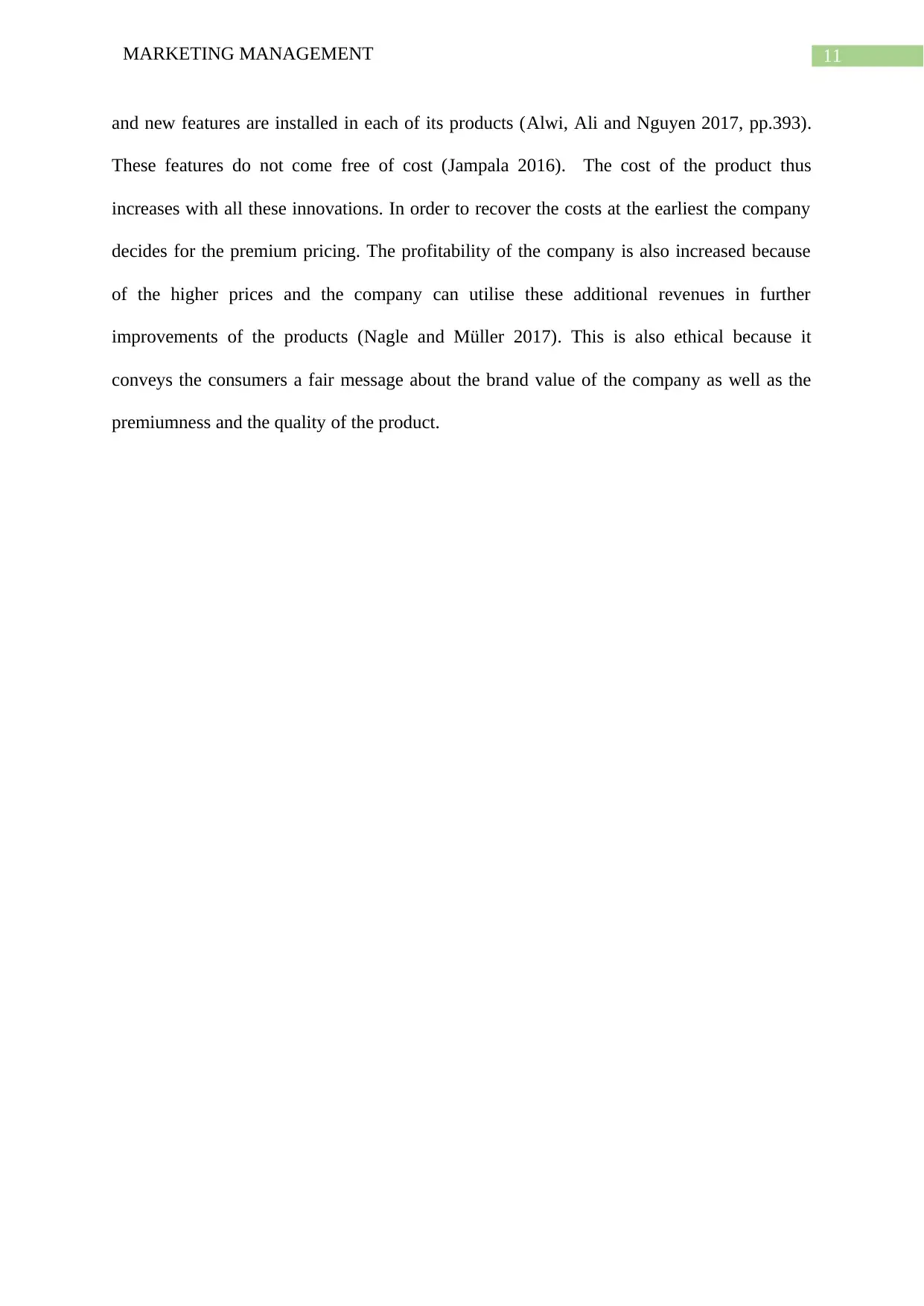
11MARKETING MANAGEMENT
and new features are installed in each of its products (Alwi, Ali and Nguyen 2017, pp.393).
These features do not come free of cost (Jampala 2016). The cost of the product thus
increases with all these innovations. In order to recover the costs at the earliest the company
decides for the premium pricing. The profitability of the company is also increased because
of the higher prices and the company can utilise these additional revenues in further
improvements of the products (Nagle and Müller 2017). This is also ethical because it
conveys the consumers a fair message about the brand value of the company as well as the
premiumness and the quality of the product.
and new features are installed in each of its products (Alwi, Ali and Nguyen 2017, pp.393).
These features do not come free of cost (Jampala 2016). The cost of the product thus
increases with all these innovations. In order to recover the costs at the earliest the company
decides for the premium pricing. The profitability of the company is also increased because
of the higher prices and the company can utilise these additional revenues in further
improvements of the products (Nagle and Müller 2017). This is also ethical because it
conveys the consumers a fair message about the brand value of the company as well as the
premiumness and the quality of the product.
⊘ This is a preview!⊘
Do you want full access?
Subscribe today to unlock all pages.

Trusted by 1+ million students worldwide
1 out of 15
Related Documents
Your All-in-One AI-Powered Toolkit for Academic Success.
+13062052269
info@desklib.com
Available 24*7 on WhatsApp / Email
![[object Object]](/_next/static/media/star-bottom.7253800d.svg)
Unlock your academic potential
Copyright © 2020–2025 A2Z Services. All Rights Reserved. Developed and managed by ZUCOL.





